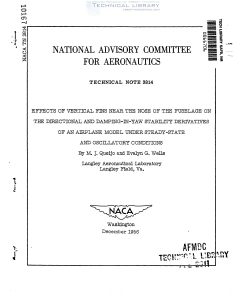naca-tn-3814
- Version
- 109 Downloads
- 1.42 MB File Size
- 1 File Count
- January 29, 2017 Create Date
- January 29, 2017 Last Updated
Effects of Vertical Fins Near the Nose of the Fuselage on the Directional and Damping-in-Yaw Stability Derivatives of an Airplane Model Under Steady State and Oscillatory Conditions

An experimental investigation has been made to determine the effects
of vertical fins near the nose of the fuselage on the directional and
damping-in—yaw stability derivatives of a swept-wing airplane model. The
investigation included measurements of these characteristics for the model
oscillating about a vertical axis in a steady airstream.
The results of this investigation showed that, for angles of attack
up to at least 12°, fins placed above the fuselage nose decreased the
directional stability but increased the damping in yaw of the model in
both the steady—state and oscillatory conditions because of the sidewash
acting on the tail as well as the direct lift of the fins. Also, fins
placed above the fuselage nose were more effective in increasing the
steady—state or oscillatory damping in yaw than the addition of an equal
amount of area at the vertical tail.
Fins placed below the nose of the fuselage decreased the directional
stability and increased the damping in yaw to a lesser extent than fins
placed above the fuselage nose in the steady-state condition but reduced
the damping in yaw in the oscillatory condition. For a constant value
of directional stability, the damping in yaw could be greatly increased
by the use of a fin placed above the nose of the fuselage and an increase
in tail size.
Some of the present-day high—speed airplanes have shown poor damping
of the lateral oscillation. This situation has led to renewed considera-
tion of methods for improving the lateral damping. One of the methods
under consideration involves the use of vortex generators located ahead
of the vertical tail. This method takes advantage of the lag of the side-
wash at the vertical tail due to the vortex generator. (See ref. 1, for
example.) The investigation in reference liwas concerned with two methods
of varying the sidewash at the vertical tail: varying the wing height
and using vertical fins with their aerodynamic centers located over the
assumed center—of-gravity position of the airplane model. This fin posi-
tion was chosen in order to minimize the loss in directional stability
while generating the desired sidewash.
| File | Action |
|---|---|
| naca-tn-3814 Effects of Vertical Fins Near the Nose of the Fuselage on the Directional and Damping-in-Yaw Stability Derivatives of an Airplane Model Under Steady State and Oscillatory Conditions.pdf | Download |

Comment On This Post